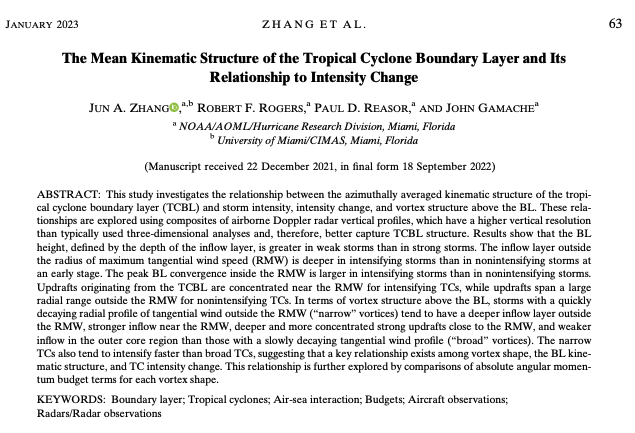The study analyzes Doppler radar profile analyses to advance our understanding of how and why tropical cyclones intensify or weaken in relation to the shape of the vortex (whether the wind field is narrow or broad) and boundary-layer structure.

Example of a mean composite of only the radial wind velocity from airborne Doppler wind profile analyses from many tropical cyclones. Negative values values show wind flowing toward the center (left edge); positive values show wind flowing away from the center. The values are averages around the entire tropical cyclone center.
Summary:
The boundary layer (BL) is the part of the atmosphere closest to the Earth’s surface where the energy from the warm water below a tropical cyclone (TC) is transferred into the atmosphere and subsequently flows toward the center, fueling the TC. We don’t yet fully understand how this transfer works and therefore sometimes have difficulty predicting TC intensity. This study investigates the relationship between observations of what is happening in the BL and TC intensity, intensity change, and structure. We explore the relationships by analyzing high-resolution NOAA P-3 airborne Doppler radar analyses of the wind directly below the aircraft from 141 different flights. We identify key differences between TCs with different rates of intensity change, especially in how fast the wind speed decreases away from where the highest wind speed is seen (the radius of maximum wind speed or RMW) and in what is happening in the BL. These differences can be used to reproduce the most accurate wind structures in our computer models to improve forecasts.

Schematic showing differences in radial (directly toward or away from the center) flow (black arrows) and vertical flow (gray arrows) for (a) narrow and (b) broad vortex. Black contours denote the speed of the tangential (swirling around the center) wind, and red shaded contours denote the speed of the radial wind. Cloud symbols denote where updrafts arising from the boundary layer lead to clouds and thunderstorms; thick light gray arrows denote radial flow above the boundary layer; and the green line denotes the top of the boundary layer. Note that the broad vortex tends to weaken, while the narrow vortex tends to intensify.
Conclusions:
- Storms in which the wind speed goes down rapidly away from the center (what we call narrow TCs) tend to intensify faster than those in which the wind speed decreases less quickly (broad TCs).
- As the inflowing air nears the center at low levels, it must rise in updrafts that are concentrated near the RMW for intensifying storms, while they span a large radial range outside the RMW for non-intensifying storms (see schematic). This is important because the rising air releases the energy driving the TC and moves air out of the BL that is fed by more inflow. If the updrafts are spread over a large area, as in broad TCs, less air flows into the center and rises there, but more rises in the outer rainbands or secondary eyewall; the inner core of the TC thus tends to weaken.
- Narrow TCs tend to have a deeper inflow layer (higher BL height), stronger inflow near the RMW, and weaker inflow in the outer core region than broad TCs (see schematic).

For more information, contact aoml.communications@noaa.gov. The study can be found at https://doi.org/10.1175/MWR-D-21-0335.1. This work was mainly supported by the Office of Naval Research’s Tropical Cyclone Rapid Intensification (TCRI) project. Jun Zhang acknowledges the support from ONR Grant N00014-20-1 -2071, NOAA Grants NA21OAR4590370, NA22OAR4590118 and NA22OAR4590178, and NSF Award #2211308.